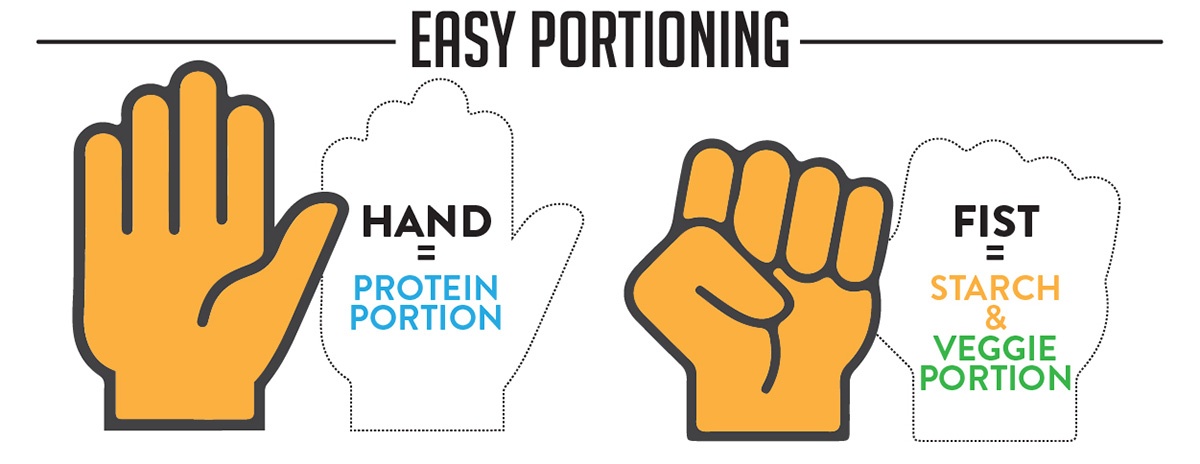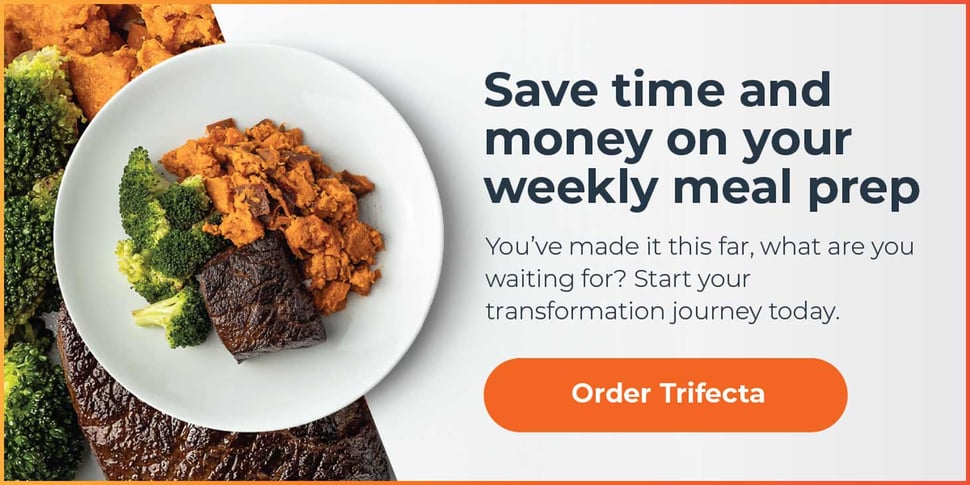Knowing your macros is one thing, but how does that translate into your food choices? Learning how to portion your meals according to your individual nutrition needs is somewhat of an art, but essential for getting you the results you're looking for. Luckily, with a little practice and the right know-how, you can master this skill and start meal prepping your own macro diet meal plan with ease. Here's your ultimate portion survival guide to get you started.
What are Macros in Food?
No matter whether you are looking to lose weight, gain muscle, or support your performance, calorie counting has long been the go-to standard for getting results. However, counting macros takes this approach one step further by helping to balance your nutrition with more structured food choices AND control calories at the same time.
Macros are your calories from food organized into nutrient groups - aka protein, fat, and carbs. Thus, counting macronutrients give you a balanced nutrition structure to strive for, while helping you control calorie intake simultaneously.
Macro diets can also offer a more flexible dieting approach, helping you to see where to treat foods and the occasional splurge fall into your daily nutrition goals as long as it “fits your macros”.
How to Start a Macro Diet
Starting a macro diet is easy. First, learn how many grams of protein, fat, and carbohydrates you need each day using this simple macro calculator. Then keep reading to learn how to build a personalized meal plan based on your unique nutrition needs.
How to Portion Food According to Your Macros
Once you’ve figured out your ideal macronutrient distributions, the next step is to convert these nutrient goals into actual meals. There are three ways to do this - all of which come in handy at different times. These include:
Weighing Your Food
The gold standard in food portion control is using a kitchen food scale. This is by far the most precise method for determining your serving sizes. Using volume measurements (like cups, tablespoons, etc.) or eyeballing it, leaves room for error.
Or if you are choosing a portion based on standard serving sizes - like a medium-sized fruit - these can still be slightly different sizes and provide slightly different calorie amounts.
Food weight scales are also incredibly easy to use and many come with automatic macro calculations built-in macro calculations. Just input the desired food code provided with the scale and weigh your portion.
Did you know??? The FDA allows food manufacturers a 20% wiggle room on packaged food serving sizes - meaning what the nutrition label says isn’t guaranteed accurate (1).
Learn More About Macro Meal Prep!
The Exchange Method
Kitchen scales are great, but they don’t allow you to menu plan in advance - enter the exchange method.
The exchange method is based on a carb-counting approach used by diabetics but it seamlessly applies to all macros and all diet types.
Using measuring cups and spoons, and associated macro food lists, you can plug and play ingredients in your meal prep to make it easier to hit your macros. All you need is a food list and associated serving sizes for each.
Essentially, one portion (or exchange) of either a carb, fat, or protein equates to a certain amount of grams for that specific macro.
|
Macronutrient |
1 Exchange Serving |
Grams |
|
Carbs |
1 each = 1/4 cup, 1/3 cup, 1/2 cup varied per individual carb |
15 g |
|
Protein |
1 each = 3 oz |
21 g |
|
Fat |
1 each = 1 Tbsp, 1.5 Tsp, 2 Tbps varied per fat |
5 g |
If your food is not listed below, simply lookup what serving equates to the appropriate grams of fat, protein or carbs and use that portion as one exchange.
Hand Fist Model
At some point, you may find yourself without a food scale or measuring cups and the need to guesstimate exactly how much you should be eating. Well, good news, you have your own portion control device in the palm of your hand already... your hand!
The size of your hand is unique and also closely aligns with your serving size requirements - the bigger your hand, the more food you need. Hold your hand up and look at your palm. One full hand is a single serving of protein. Now make a fist, one fist is a single serving of starches, and 2 fists are a standard serving of veggies. And lastly, your thumb equates to one serving of fat.

To use the hand-fist model, you’ll need a food list and the following nutrient estimates to estimate how many grams of carbs, fat, and protein you’re eating.
|
Hand Portion |
Macronutrient |
Estimated Measurement |
|
Protein = 1 palm |
~20-30 g |
~3-4 ounces meat, 2 whole eggs, 1 cup Greek yogurt |
|
Carbs = 1 cupped hand |
~20-30 g |
~½-⅔ cups cooked grains, beans, or legumes, or 1 medium fruit |
|
Fats = 1 thumb |
~7-12 g |
~1 tablespoon |
Macros Food Lists
Now you’re ready to start choosing your macro-friendly foods to build a breakfast, lunch, and dinner that will help you hit your macros every day of the week.
Here is your complete macro food list breakdown so you plan your grocery list accordingly.

What Counts as a Carb or Starchy Food?
Carbohydrates are sugars, fibers, and starches, and come from anything that grows out of the ground, and dairy. This includes fruits, vegetables, beans, legumes, and grains, as well as some milk and yogurt.
Carbohydrates also come from added and naturally occurring sugars like table sugar, honey, maple syrup, agave, etc. (this does not include artificial sweeteners).
Here is your portion list of carbohydrate foods/starchy foods:
|
Carb |
1 Exchange Serving |
|
Rice, cooked |
1/3 cup |
|
Quinoa, cooked |
1/4 cup |
|
Whole wheat pasta, cooked |
1/2 cup |
|
Barley, cooked. |
1/3 cup |
|
Farro, cooked |
1/3 cup |
|
Sweet potato |
1/2 cup |
|
Mashed potato |
1/2 cup |
|
Beans (black, pinto, lima, black-eyed peas) |
1/3 cup |
|
Legumes, cooked |
1/3 cup |
|
Peas |
1/2 cup |
|
Corn |
1/2 cup |
|
Bread, whole wheat |
1 slice = 15 g/slice (+/-2-3g ok) |
|
Bagel, whole wheat |
1/2 each |
|
English muffin, whole wheat |
1/2 each |
|
Corn tortillas |
2 each (4”) |
|
Oatmeal, cooked |
1/2 cup or 1 package |
|
Cereals, cold |
1/2 - 3/4 cup (varies per cold cereal) |
|
Graham Crackers |
2 each |
|
Pretzels, Chips |
3/4 cup |
|
Milk, skim |
1 cup |
|
Whole Fruit |
1 medium or ½ banana |
|
Berries |
1 cup |
Find Out How To Lose Weight While Eating Carbs
Non-starchy Vegetables
While starchy vegetables would fall under the carb section of the plate, non-starchy are not significantly high in carbs, protein, or fat, and have their own section.
Non-starchy veggies are mostly water and provide few calories. They are also high in nutrient density, meaning you can eat a lot more for a lot less calories. Eating more veggies can also help make sure your micronutrient intake is up to par!
Non-starchy veggies or “free foods” include:
- Artichoke
- Asparagus
- Broccoli
- Carrots
- Cauliflower
- Celery
- Cucumber
- Green Beans
- Leafy Greens
- Mushrooms
- Radishes
- Summer Squash
- Tomatoes
- All other veggies
What Counts as a Protein?
Whole food proteins come from meat, dairy, and plant-based sources.
Here is your list of protein foods:
|
Protein |
1 Exchange Serving |
|
Salmon, shrimp, tuna, cod, halibut, scallops |
3 oz |
|
Lean beef, turkey, chicken, pork |
3 oz |
|
Jerky |
1.5 oz |
|
Greek yogurt, nonfat |
1 cup |
|
Cottage cheese, 2% fat |
3/4 cup |
|
Whole eggs |
2 eggs |
|
Egg whites |
4 egg whites/1 cup |
|
Egg substitute |
1/4 cup |
|
Tofu, extra firm |
1/2 block |
|
Edamame |
1/2 cup |
What About Fat?
Fats typically act as a topping or extra ingredient. If you are trying to gain weight, fats are an easy way to add calories without adding a lot of volume. But if you are looking to lose body fat, they should be kept moderate.
Here are some common ways you can add healthy fats to your plate:
|
Fat |
1 Exchange Serving |
|
Nut butter |
1 Tbsp. |
|
Nuts (walnuts, pecans, almonds, brazil nuts) |
10-15 each |
|
Avocado |
⅓ fruit |
|
Olives |
7 small or 2-3 large |
|
Seeds (chia, flax, etc.) |
2 Tbsp. |
|
Plant oils (olive oil, avocado oil, coconut oil, etc) |
1.5 Tsp. |
|
Butter |
2 Tsp. |
|
Cheeses |
1 oz. |
If your food is cooked with fat or naturally contains fat, you probably do not need to add any additional fat. But if you are eating very lean, plain foods, you may want to add a little fat for flavor and satiety.
Macro Foods Tracker
While macro foods lists work great in theory, many foods contain a combination of macronutrients and could fall into more than one category. This is why tracking your macros is the final step of the process to ensure success. This will give you a better overview of how well you are doing each day and can also provide weekly macro averages to check in on your long-term progress.
Download the free Trifecta app now to start tracking your macro meal plan!
Ready to start meal prepping to meet your macros? Download the FREE macro meal-planning guide, complete with food lists and more!





